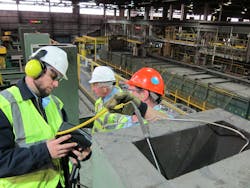Increasing your plant's energy efficiency doesn't have to be a solo mission. There's a large, highly successful community of like-minded manufacturers waiting for you to join up.
The U.S. Department of Energy (DOE) Better Plants program challenges manufacturers to set aggressive energy intensity reduction goals and provides resources to help participants achieve them. This year, Better Plants highlighted the accomplishments of electrical and network infrastructure provider Legrand, brewer Deschutes and packaging products and systems manufacturer Intertape Polymer Group [a two-time IndustryWeek Best Plants winner].
All three companies met and exceeded their energy reduction goals and spoke with IndustryWeek about how the Better Plants program works and what participants may expect in the way of support and encouragement to achieve their goals.
Energy Efficiency Needs Leadership
Legrand has since 2007 published corporate responsibility roadmaps that convey broad global sustainability targets. Susan Rochford's position, vice president of energy efficiency, sustainability and public policy for Legrand North and Central America, was created by the CEO of Legrand North America to drive the company's commitment to sustainability.
Energy intensity measures how many units of energy it takes to achieve a specific activity. Reducing energy intensity means completing the same activity but with less energy expenditure. Legrand joined the Better Plants program in 2011, committing to a 25% energy intensity reduction over 10 years across a defined set of plants.
"We didn't have a roadmap. We didn't know how we were going to get there. But we believed it was important as a means to start to demonstrate our commitment to operating as a more sustainable company," says Rochford. To achieve the goal, Legrand had to make some leadership changes.
The first step was appointing a corporate Energy Manager to help guide energy saving activities and initiatives. Each participating site also needed someone to pay attention to energy consumption, look for patterns and find potential projects to save energy. This created an internal network within the entire company to guide energy saving efforts.
"Better Plants has certainly been a really important investment in building the internal competencies to manage our energy better and to recognize the opportunities to do so and give us the structure on how to go about that," Rochford says.
Collaboration Creates Energy Saving Opportunities
Intertape Polymer Group [IPG], an Energy Star industrial partner that works with the Association of Energy Engineers (AEE) started its corporate energy team also in 2007. It was through an AEE conference that IPG learned about the Better Plants program.
"[Our energy saving programs] were pretty well developed, but we always have more we can do, and bringing new organizations in like DOE and more technical experts can only help," says Mike Jones, director of corporate energy at IPG. The company looked to the Better Plants program to find energy saving opportunities that IPG had missed.
Peer-to-peer networking and cooperation serve as key elements in finding those opportunities. For instance, at an in-plant assessment at IPG's plant in Danville, Virginia, the company hosted DOE technical experts as well as local manufacturers to discuss topics like process heating, compressed air pumping and chilled water systems.
"Several ideas came out of that. One of them in particular was installing a variable frequency drive air compressor and becoming more energy efficient in the process," Jones says.
"That was one of several ideas that were put forth, just one example, but it opened our eyes to what's possible. Sometimes you don't implement everything for various reasons, but if you can get one or two projects going through something like this activity, it makes it all worth it," Jones adds.
On The Hunt for Energy Savings
Mark Fischer, director of operations at brewer Deschutes, says his company also already had sustainability efforts in place before discovering the Better Plants program. Where the DOE helped best was finding the smaller opportunities to save energy with "treasure hunts."
"It's basically a walkthrough of your facility, looking for opportunities to save energy. And it might be something as simple as a fan or an exhaust fan that runs all the time that you could shut off, you know, eight hours a day. Simple things like that," Fischer says.
"A treasure hunt is really all about looking at things with a fresh set of eyes," says John O'Neill, Better Plants Program Manager at the DOE. "You might have somebody that's not necessarily on the production floor on any given day come and take a look at it and ask questions. 'Why do we do something this way? Why is that on? Why is that open? That sort of thing.’"
Deschutes invites employees to join treasure hunts, turning them more into an event. "It helps motivate people when they see their company doing something good and doing something that is going to help the bottom line," Fischer says.
IPG also invites operators on treasure hunts to tap into their process expertise and find new opportunities to increase efficiency.
"People want to work for a company that cares about sustainability, especially the younger generation. They're really in tune with that, and it's important to them," Jones says. "The more we can get them involved, the better our program is going to be."
Big Success Means Continuing Partnerships
Not only did Legrand achieve the target 25% energy intensity reduction it pledged to meet in 2011, it set and met a 20% reduction goal and this year achieved a 14.1% reduction against a 5-year goal of only 13%. Legrand is also doubling down on efforts to introduce its suppliers to the benefits and resources of Better Plants.
"All the efforts that the companies and organizations are making are in support of the broader mission of the department and the types of things we're trying to achieve as a country…it's like continuous learning, and we have a veritable partner. I think [Better Plants] is one of the best examples of public private partnership that I've seen," says Rochford.
Deschutes committed to the Better Plants program to reduce energy intensity by 10% over five years. It achieved a 10.2% reduction in 2022, only three years after making the pledge.
"Because of the tools they offer, I think we're going to stay involved with this for a long time," Fischer says. "We just set a greenhouse gas reduction goal that goes for 10 years."
IPG set a 10-year 25% energy reduction goal when it joined the Better Plants community. Instead, this year IPG announced it had achieved a 38.5% reduction in only seven years.
"When you don't reach out and get other organizations involved you reach a plateau, and it's hard to improve after that. So you really need help from other organizations like DOE to move the needle and continue to learn as an organization on how to improve," says Jones.






